The war in Europe began when Adolf Hitler's German troops invaded Poland on September 1, 1939, the second in a series of Nazi conquests of European states (Austria and Czecholslovakia had already fallen victim to Germany). In the days that followed, Britain, France, Australia, New Zealand, and Canada responded by declaring war on Germany, while the United States declared neutrality. The Soviet Union, like Italy, had signed a pact with Germany and joined the aggression, following the Nazis into Poland and, later, declaring war on Finland.
The Nazis continued to sweep through Europe the following year, taking control of Holland, Belgium, Norway, and France. The Battle of Britain began that summer, with German Blitz bombing raids on London and major port cities. In the meantime, the Soviets had taken Lithuania, Latvia, and Estonia, and Mussolini's Italian Fascist troops were advancing into Africa, Egypt, and Greece. Concerned by the takeover of France, the United States initiated the first peacetime conscription in its history on October 16, 1940.
Still reluctant to involve the United States in the war in Europe, President Franklin D. Roosevelt signed the Lend-Lease Act on March 11, 1941. Lend-Lease provided aid to countries whose defense "against agression is vital to the defense of the United States." The Act empowered the President to sell, lend, or lease such articles as ships, aircraft, weaponry, equipment or supplies for manufacture of defense articles, and food and other supplies, not to exceed $1.3 billion. Because several U.S. merchant ships had been lost to U-boat activity in the Atlantic, the Act dictated that convoys to Britain and other Lend-Lease countries were not to be accompanied by U.S. Naval ships, nor would U.S. ships be authorized to enter combat zones.
Germany continued its march through Europe, taking Yugoslvia and Greece. Nazi General Erwin Rommel and his "Afrika Korps" landed in North Africa early in 1941, and the Germans turned on the Soviet Union soon after. German, Italian, and Japanese assets in the United States were frozen, and the U.S. imposed an oil embargo on agressor nations. On August 14, 1941, following a series of conferences, President Roosevelt and British Prime Minister Winston Churchill jointly issued the Atlantic Charter, which put forth a plan for lasting peace for the post-war world.
America's Isolationist stance changed in the blink of an eye when Japan attacked Pearl Harbor on the island of Oahu, Hawaii on the morning of December 7, 1941. The following day the U.S. declared war on Japan. Germany retaliated by declaring war on the United States on December 11th, and by January 1942 had a fleet of U-boats lurking off the east coast of the U.S. The first American forces were sent to Great Britain in anticipation of a massive cross-channel invasion by the end of January, and the first American bombing raids over Europe commenced in August. German activity in North Africa delayed the invasion and, in November, U.S. troops were sent to the African front.
Following the defeat of the Germans in Africa in 1943, the U.S. and Britain turned their attention to Sicily and Italy. By September, Mussolini had been arrested and Italy had surrendered to the Allies. The fighting continued into 1944 as the Allied forces pushed their way through Italy, reaching Rome in early June.
While British and Americans were driving the Germans out of Italy, a massive buid-up of troops, 6,000 ships and 11,000 aircraft from many countries was underway in Great Britain for "Operation Overlord," the D-Day invasion. On June 6, 1944, more than 120,000 Allied ground and airborne troops landed on the beaches of Normandy. By nightfall the Allies had gained a foothold in France, but had sustained nearly 5,000 casualties. Within a few weeks of the invasion 850,000 men and 150,000 military vehicles had arrived in Normandy.
During the summer of 1944, the Allies fought their way inland, liberating Paris on August 25th. American and British bombing raids over Germany crippled industrial sites and cities. In September 30,000 American and British paratroopers were dropped into Holland in "Operation Market Garden," a failed attempt at clearing the way for an Allied advance across the Rhine River into Germany.
In December 1944 Hiltler reorganized his troops, sending them on a mission to cut off the Allies in Belgium and retake the port of Antwerp. The resulting "Battle of the Bulge," the last German offensive action on the Western Front, caught the Americans off-guard. Allied aircraft, grounded due to weather conditions, eventually provided the support needed to beat back the Nazis by the end of January 1945.
The Allied forces reached the Rhine in March and the first troops crossed into Germany and moved toward Berlin. With the Russians closing in from the East, and the Americans advancing from the West, German resistance dwindled by the end of April. Hitler committed suicide in Berlin on April 30th, and his successor, Grand Admiral Karl Doenitz, had no alternative but to surrender. His emissary, General Alfred Jodl, signed an unconditional surrender at the headquarters of the Supreme Allied Commander, General Dwight D. Eisenhower, at Reims on May 7th, which took effect at one minute past midnight on May 8, 1945.

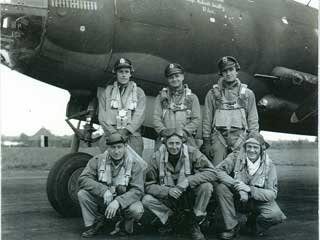

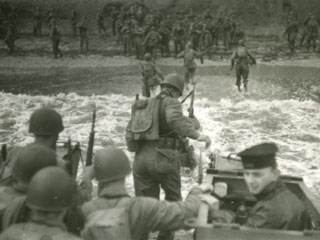
Fighting For The Right
The United States and Britain declared war on Japan on December 8, 1941 following the attack on Pearl Harbor. Germany, which had joined Italy and Japan in signing the Tripartite Pact to form the Axis Powers military alliance in September 1940, reciprocated on December 11, 1941 by declaring war on the U.S., thereby plunging the United States into the war on two fronts.
American troops began to arrive in Europe in late January 1942, but were not immediately engaged in combat. The first American air attack in Europe took place in August, and "Operation Torch," the U.S. invasion of North Africa, an attempt to assist the British in driving back German and Italian forces and secure control of the Suez Canal and the Mediterranean, followed in November.
After defeating the German "Afrika Korps" under field marshall Erwin Rommel, in Africa in the spring of 1943, the Allied forces crossed the Mediterranean, fighting their way through Sicily and landing on the Italian coast by September. Minnesotans fighting with the 34th Infantry "Red Bulls" Division and the First Battalion of U.S. Army Rangers, many of whom had come out of the 34th, were among the first American troops sent to Europe, and were instrumental in both North African and Italian campaigns. The battles of both campaigns, fought in difficult terrain, cost the Allies many casualties, but served the purpose of keeping German forces engaged away from the coast of France, helping to clear the way for the D-Day Invasion on the beaches of Normandy the following June.
The Normandy Invasion, codenamed "Operation Overlord," was the largest seaborne invasion in history. On D-Day more than 120,000 Allied troops landed in France. Many Minnesotans played a part in the invasion on Omaha and Utah beaches and the surrounding area. They served with the 82nd and 101st Airborne Divisions, the Second and Fifth Ranger Battalions, and other divisions in the First Army under General Omar N. Bradley. Those that survived the landing had a hard fight against German artillery to get beyond the beaches, finally breaking out in late July.
In September 1944, members of the 82nd and 101st Airborne Divisions joined a British Airborne Division in an attempt to secure the bridges over the Rhine River necessary to the incursion of Allied forced into Germany. The ensuing Battle of Arnhem, or "Operation Market Garden," was ultimately a failure, and in December the Germans launched a brutal final offensive in the forests of the Ardennes in eastern Belgium and Luxembourg - the Battle of the Bulge.
The Allies made their way toward Berlin and a meeting with the Russian forces coming from the east, liberating prisoners of war held in concentration and labor camps along the way. German resistance lessened until the surrender came on May 7, 1945.
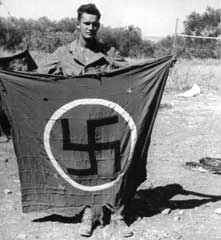
Experiences Abroad
Minnesotans serving abroad during World War II had many extraordinary experiences beyond those of combat. For a good number of them who had never been outside the state of Minnesota, the war presented an unexpected opportunity to visit distant places, mingle with a wide variety of people, and to face new situations.
Alexandria, Minnesota native Reverend Delbert Kuehl, as a chaplain assigned to the 82nd Airborne Division, found new ways to minister to his men as they lay dying on the fields of the Netherlands following a disastrous crossing of the Waal River in Holland.
Betty Magnuson Olson of Duluth joined the Women's Army Corps (WAC) and found herself spending Christmas 1944 in the newly liberated city of Paris.
William L. Anderson of Minneapolis wrote home from Tunisia, North Africa of a touching moment of comraderie among his fellow soldiers one evening in camp.

Shipping Out
Leaving home was a new experience for many members of Minnesota's Greatest Generation, many of whom had never been beyond the borders of their home counties before the war. Most saw military service as a duty, some as a grand adventure. Many would not return. Those that did would have a greatly expanded perspective on their world.
Fort Snelling, in St. Paul, was the first stop for more than 300,000 new recruits during the war years. There they received a thorough medical exam to confirm their suitability for service. All were required to take the Army General Qualification Test and underwent a personal interview to determine where individual skills might best be used. Recruits were issued uniforms and given the necessary injections. Once fully processed, they were sent home to wait for transportation orders.
The next stop was a military "boot" camp stateside where they would receive their basic training, with the location dependent upon the branch of service. For many Minnesota men entering the Army, that meant six weeks at Camp Claiborne, Louisiana. For women of the Women's Army Auxiliary Corps (WAAC), the destination was likely Fort Des Moines in Iowa. Many new Navy recruits from Minnesota found themselves at the Great Lakes Naval Training Station in Chicago, while Women Auxiliary Volunteers for Emergency Service (Navy WAVEs) and women Marines went to Hunter College, the Bronx, New York for basic training.
After a few weeks of basic training each was sent to a specialty training facility, depending upon their new assignments. Some men were transferred to an air base for flight training. Others received medical or clerical training, or were sent to schools to become artillerymen or paratroopers. When training was completed, servicemen were sent to a staging camp, such as Camp Shanks, New York and Fort Dix, New Jersey on the east coast, or to a port of embarkation such as San Francisco in the west - the final stop before shipping out for "unknown destinations" abroad.
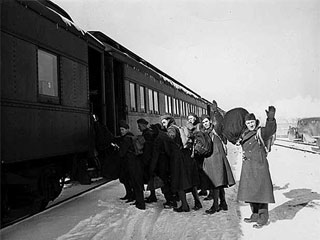
POWs and Liberators
As World War II raged on, stories of the atrocities committed on Prisoners of War by the Germans and the Japanese inspired fear and loathing in American servicemen. To many, to become a Prisoner of War was a fate worse than death.
In Europe, POWs faced forced marches covering hundreds of miles with no shoes and inadequate clothing, little or no food or water, and no medical care. Upon reaching the prison camp, they endured starvation, sickness, torture, and the deaths of comrades. Ranger Donald S. Frederick, captured in Italy, was moved from camp to camp for fourteen months before liberation finally came.
The unspeakable horrors of the genocide committed on Jewish men, women and children, gypsies, and political prisoners in the Nazi Death Camps at Auschwitz, Dachau, Buchenwald, Gardelegen, and others will forever haunt the minds of those whose families suffered there, and of those who liberated them. Six million people perished in the Nazi attempt to eliminate "undesirables." Dr. Reuben Berman was among the first Allied troops to reach Dachau, and filed an official report on his observations there. Ranger Harry J. Herder, Jr. helped to liberate Buchenwald, and found an unlikely friend while on guard duty. Edmund S. Motzko happened upon the camp at Gardelegen, not long after the Nazis had fled, and witnessed the aftermath of the atrocity committed there.
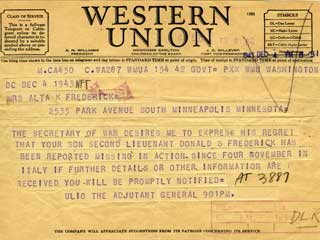
V-E Day and Coming Home
"Germany Surrenders!"
When Germany officially surrendered on May 8, 1945 Americans became cautiously optomistic that a Japanese surrender wouldn't be far behind. Even so, with the invasion of the home island of Japan still a possibility, many felt it inappropriate to celebrate a peace that was only "half-won," particularly those in the military for whom peace had come at a high cost.
President Harry S. Truman's speech on V-E Day called upon all Americans to remember those whose lives had been sacrificed, and to work to finish the fight to free the world of tyrrany in the Pacific and to "build an abiding peace."
Those on the home front with loved ones in Europe rejoiced. Local newspapers heralded the news of the end of hostilities in Europe, and many Minnesotans took to the streets to join in impromptu V-E Day celebrations. Others waited in line to get into their churches to give thanks for the hard-won peace, and pray for the safe return of family members serving abroad.
For servicemen and women stationed in Europe, the return to the States was slow in coming. The Adjusted Service Rating System (ASR) was implemented after V-E Day to determine what military personnel were eligible to be discharged and who would be retained for occupation duty or redeployment to the Pacific. The ASR awarded points for months of service and battle achievements. Servicemen with a rating of 85 points were eligible to return home; women with 44 points were also eligible for discharge.
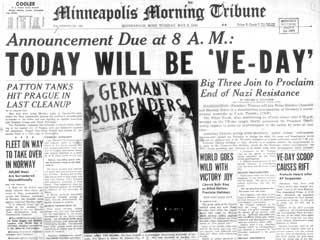
Flying Coffins: MN-Made WWII Gliders
Early in the war the German army began to use a new - and silent - weapon: motorless glider aircraft, which enabled them to quietly penetrate Allied lines with troops and equipment. The U.S. and Britain quickly began to produce their own gliders, which would play an important role in both European and Pacific Theaters.
The U.S. gliders were developed by the Waco Aircraft Manufacturing Company based in Troy, Ohio in 1942. The original design, which was designated CG-4A (C for cargo, G for glider), was for an aircraft approximately 48 feet in length with nearly an 84-foot wingspan that could carry a pilot, co-pilot, and thirteen fully-equipped infantrymen or one jeep, bulldozer, or other piece of equipment (to a maximum of 3,750 pounds). A second, larger model, the CG-13A, was designed to carry thirty men. The gliders were towed on a 350' nylon rope, most commonly by C-47 transport planes and, once released, began a rapid descent to a designated target area.
Made of a welded tubular steel frame, thin plywood and laquered canvas, and designed for a single use, the gliders were so dangerous that it was said that once released from the tow plane, those on board had a life expectancy of just 17 seconds. Many men lost their lives or were injured when the gliders crash-landed. Pilots and co-pilots were crushed when rough landings caused the cargo to break free from its moorings and come crashing forward. Some did not survive the glider training program. The dangers earned the 3,700 pound planes the nickname "Flying Coffins".
Because the Army Air Force needed a large number of gliders, construction contracts were awarded to sixteen manufacturers around the country that could efficiently produce the necessary components but were not involved in building the powered aircraft needed by the military. The Northwest Aeronautical Corporation (NAC) of St. Paul, headed by John E. Parker, was given one such contract in 1942 for the delivery of 30 CG-4A gliders - a number later increased to 300. NAC subcontracted the work to two primary manufacturers, Villaume Box and Lumber Company of St. Paul, and the De Ponti Aviation Company in Minneapolis. Villaume had the capacity to build the wooden wings and honeycombed wood cargo floors, while De Ponti handled the steel components, such as the frame for the fuselage, the tail assemblies, and landing apparatus. Glider manufacturing in the Twin Cities employed thousands of workers, including a large number of women. By the beginning of 1945, when glider production stopped, NAC had produced some 1,500 CG-4As, each costing an average of just over $24,500, and 47 CG-13A gliders.
Gliders were first used in combat by the U.S. in July 1943 when 137 gliders participated in the invasion of Sicily, although only a small percentage of them reached their target area, and many were lost in the sea. The following March a smaller group flew a more successful mission, bringing troops and supplies into Burma. Hundreds of gliders played an important role in the Normandy Invasion in June 1944, and were employed in the attempt to secure bridges in Holland in September of that year. On March 24, 1945 1,348 American and British gliders were used in a mission to aid the Allied forces in crossing the Rhine. All glider missions were perilous and, even when successful, cost lives.
[Editor's note: Because of the gliders' disposable quality, only a handful of restored World War II WACO gliders remain in museums today. At the time of this writing, a local group of glider enthusiasts in the Twin Cities led by James Johns is in the process of restoring a CG-4A and a CG-15 glider in space provided by Nick Linsmayer, president of Villaume Industries, Inc., whose company, formerly Villaume Box and Lumber Company, was one of Northwest Aeronautical Corporation's original subcontractors. To learn more about the glider building program in Minnesota, read our Rosie the Riveter story collection.]
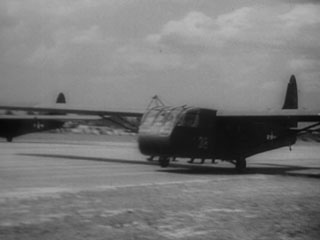
Citations:
 Person: Adolf Hitler.
Person: Adolf Hitler.- National Socialist German Workers Party. Wikipedia.org, 2007.
- The Battle of Britain. The Battle of Britain Historical Society, 2006.
- Blitzkrieg. Wikipedia.org, 2007.
- Martin, Dr. James J., Peacetime Registration for Conscription - Forty Years Ago. The Journal for Historical Review, Spring 1982, vol. 3, no. 1, p. 15.
- Selective Training and Service Acto of 1940. Wikipedia.org, 2007.
 Person: Franklin Delano Roosevelt.
Person: Franklin Delano Roosevelt.- Lend Lease Act, 11 March, 1941. Navy Historical Center, 1999.
- U.S. Merchant Marine in World War II. American Merchant Marine at War, U.S. Maritime Service Veterans, 1998-2007.
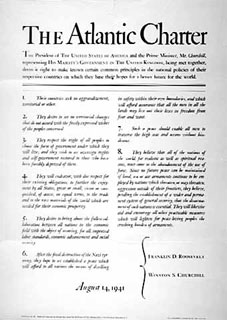 Object: The Atlantic Charter, August 14, 1941.
Object: The Atlantic Charter, August 14, 1941.- Atlantic Charter. Wikipedia.org, 2007.
- Benito Mussolini. Wikipedia.org, 2007.
- D-Day, June 6, 1944. D-Day: The National World War II Museum, 2006.
- Pearl Harbor Raid, 7 December, 1941. Naval Historical Center, 2000-2001.
- Normandy. The United States Army Center of Military History, 2003.
- Operation Market Garden. Wikipedia.org, 2007.
- Battle of the Bulge. Wikipedia.org, 2007.
 Person: General Dwight D. Eisenhower.
Person: General Dwight D. Eisenhower.- Biography of Dwight D. Eisenhower. The White House, 2007.
- Tripartite Pact. Wikipedia.org, 2007.
- European Timeline, World War II 60th Anniversary Committee, 2005.
- Avery, Steve, Editor, Wars and Battles: North African Campaign, 1940-1943. U-S-History.com, 2002-2005.
- North Africa Campaign. MSN Encarta, 2007.
- Erwin Rommel. Wikipedia.org, 2007.
- Minnesota National Guard 1941-1945. Minnesota National Guard, 2007.
- 34th Infantry Division Association. 2007.
- World War II Army Rangers. 2002-2008.
- Italian Campaign (World War II). Wikipedia.org, 2007.
- D-Day Invasion. MSN Encarta, 2007.
- The Battle of Normandy. Wikipedia.org, 2007.
- The Main Phases of the Battle of Normandy. Normandie Mémoire, 2007.
- First U.S. Army History. First Army, 2007.
- Omar Bradley. Wikipedia.org, 2007.
- Italy: Introduction to the Italian Campaign. World War II History Info, 2001-2004.
- Animated Map: The Battle of Arnhem. BBC, 2007.
- Cross, Robin The Battle of the Bulge. BBC, 2005.
- Anderson, William L. William L. Anderson Papers. Minnesota Historical Society Manuscript Collection.
- Kuehl, Rev. Delbert; Thomas Saylor, Interviewer, Minnesota's Greatest Generation Oral History Project, Thomas Saylor; Minnesota Historical Society Oral History Collection, 2003.
- Olson, Betty J. Magnuson, A WAC's War: Reminiscences. Minnesota Historical Society Manuscripts Collection, 1965.
- Osman, Stephen E., Fort Snelling's Last War. Minnesota Historical Society, 2007.
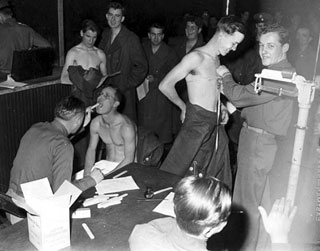 Photo: Medical Examination for Inductees at Fort Snelling, 1942.
Photo: Medical Examination for Inductees at Fort Snelling, 1942.- Fort Des Moines. Minnesota Historical Society Photograph Collection, 2007.
- Duis, Perry R., Great Lakes Naval Training Station. Encyclopedia of Chicago, 2005.
- Camp Shanks. New York State Military Museum and Veterans Research Center, 2006.
- Fort Dix. Wikipedia.org, 2007.
- Frederick, Donald S.; Thomas Saylor, Interviewer, Minnesota's Greatest Generation Oral History Project, Minnesota Historical Society Oral History Collection, 2005.
- Berman, Dr. Reuben, Reuben Berman and Family Papers, 1943-1945. Minnesota Historical Society Manuscripts Collection.
- Text: A Catharsis.
- Motzko, Edmund S.; Sandy Kibort, Interviewer, Minnesota Liberators of Concentration Camps Oral History Project. Minnesota Historical Society Oral History Collection.
- Truman, Harry S., President Harry S. Truman's speech on the surrender of Germany, May 8, 1945. Truman Presidential Museum and Library.
- V-E Day Front Page News. Minnesota Historical Society: Minnesota's Greatest Generation, 2005.
- Lindley, John M., "A Great Experience" - Villaume builds Gliders in World War II. Ramsey County History. St. Paul: Ramsey County Historical Society, Vol. 41, no. 4, Winter 2007, p. 22-27.
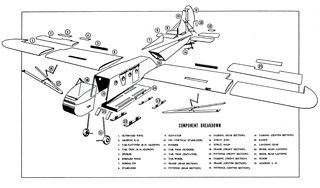 Document: Diagram of a CG-4A glider.
Document: Diagram of a CG-4A glider.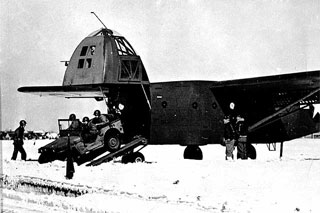 Photo: A military jeep is unloaded from a CG-4A glider in a training exercise.
Photo: A military jeep is unloaded from a CG-4A glider in a training exercise.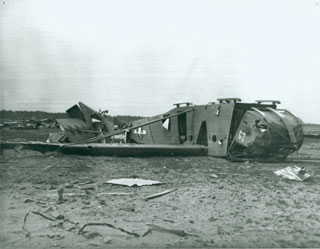 Photo: Landing a glider was dangerous, with many crash-landings causing injury and death to those on board.
Photo: Landing a glider was dangerous, with many crash-landings causing injury and death to those on board. Photo: Villaume Box and Lumber Company, Chicago Avenue (northwest corner Walter), St. Paul, 1950-1959.
Photo: Villaume Box and Lumber Company, Chicago Avenue (northwest corner Walter), St. Paul, 1950-1959.- Trimble, Steven C., "If it can be manufactured from wood, we can make it": a hsitory of the Villaume family and the company they built Ramsey County History. St. Paul: Ramsey County Historical Society, Vol. 41, No. 4, Winter, 2007, p. 4-21.
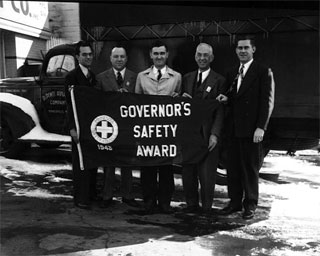 Photo: Employees of DePonti Aviation holding Governor's Safety Award flag, 1943.
Photo: Employees of DePonti Aviation holding Governor's Safety Award flag, 1943.- DePonti, Angelo, Angelo DePonti papers, 1929-1991. Minnesota Historical Society Manuscripts Collection. Call no. P1999.
 Photo: Two Villaume workers put the finishing touches on a glider wing, ca. 1943-1945.
Photo: Two Villaume workers put the finishing touches on a glider wing, ca. 1943-1945. Photo: Honeycombed cargo floor for a CG-4A glider, built by Villaume Box & Lumber Company, ca. 1943-1945.
Photo: Honeycombed cargo floor for a CG-4A glider, built by Villaume Box & Lumber Company, ca. 1943-1945.- Rosie The Riveter. In Their Words: Stories of Minnesota's Greatest Generation, Minnesota Historical Society, 2009.


